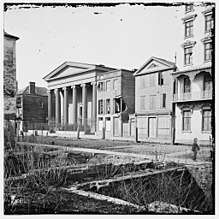Hibernian Hall (Charleston, South Carolina)
|
Hibernian Hall | |
|
| |
  | |
| Location | 105 Meeting St., Charleston, South Carolina |
|---|---|
| Coordinates | 32°46′38″N 79°55′54″W / 32.77722°N 79.93167°WCoordinates: 32°46′38″N 79°55′54″W / 32.77722°N 79.93167°W |
| Built | 1840 |
| Architectural style | Greek Revival |
| Part of | Charleston Historic District (#66000964) |
| NRHP reference # | 73001686 |
| Significant dates | |
| Added to NRHP | November 7, 1973[1] |
| Designated NHL | November 7, 1973[2] |
| Designated NHLDCP | October 9, 1960 |
Hibernian Hall is a historic meeting hall and social venue at 105 Meeting Street in Charleston, South Carolina, United States. Built in 1840, it is Charleston's only architectural work by Thomas Ustick Walter, and a fine example of Greek Revival architecture. It is nationally significant for its use during the 1860 Charleston Convention, in which the Democratic Party, divided by opinions on slavery, failed to select a presidential nominee, ensuring victory for the anti-slavery Republican Party in the 1860 presidential election. The building was designated a National Historic Landmark in 1973.[2][3] The building continues to be used as a function and meeting space today.
Description and history


Hibernian Hall is located at 105 Meeting Street, just north of the intersection of Meeting and Broad Street in central Charleston, an intersection known as the "Four Corners of Law". The hall was constructed in 1840 to a design by Thomas U. Walter of Philadelphia for the Hibernian Society of Charleston, an Irish benevolent society. It is the only known work of Walter's in Charleston. It is a two-story brick structure, clad in white-painted stucco, its principal architectural feature a Greek temple front with six Ionic columns, supporting an entablature and pediment. The architect modeled the columns and entablature on those of the Temple of Illisius, [4] but the effect has been modified by the addition of dentils and modillions to the cornice, and the insertion of an arched Italianate window into the tympanum of the pediment, alterations made after the building was damaged in the 1886 Charleston earthquake. Christopher Werner crafted the iron gates.[5]
Hibernian Hall is the only remaining building associated with the 1860 Democratic National Convention, one of the most critical political gatherings in United States history. The building served as convention headquarters for the faction of the Democratic Party supporting presidential candidate Stephen A. Douglas. The first floor was used as a meeting space, and the second floor as living quarters for the delegates, who slept on hundreds of cots set up for the occasion. No one Democratic candidate could garner sufficient support, and the party's divisiveness led to the election of the Republican candidate, Abraham Lincoln.
See also
References
- ↑ National Park Service (2007-01-23). "National Register Information System". National Register of Historic Places. National Park Service.
- 1 2 "Hibernian Hall". National Historic Landmark summary listing. National Park Service. Archived from the original on 2011-06-06. Retrieved 2008-03-21.
- ↑ Tray Stephenson and Bernard Kearse (April 19, 1973), National Register of Historic Places Inventory-Nomination: Hibernian Society Hall (pdf), National Park Service and Accompanying two photos, exterior, from 1973 (32 KB)
- ↑ Maurie D. McInnis. The Politics of Taste in Antebellum Charleston (University of North Carolina Press, 2005), pages 104–108.
- ↑ "Hibernian Hall". Charleston Historic Religious & Community Buildings. National Park Service. Retrieved 11 January 2012.
External links
- Hibernian Hall, Charleston County (105 Meeting St., Charleston), with 5 photos, at South Carolina Department of Archives and History
- Historic Charleston's Religious and Community Buildings, a National Park Service Discover Our Shared Heritage Travel Itinerary

